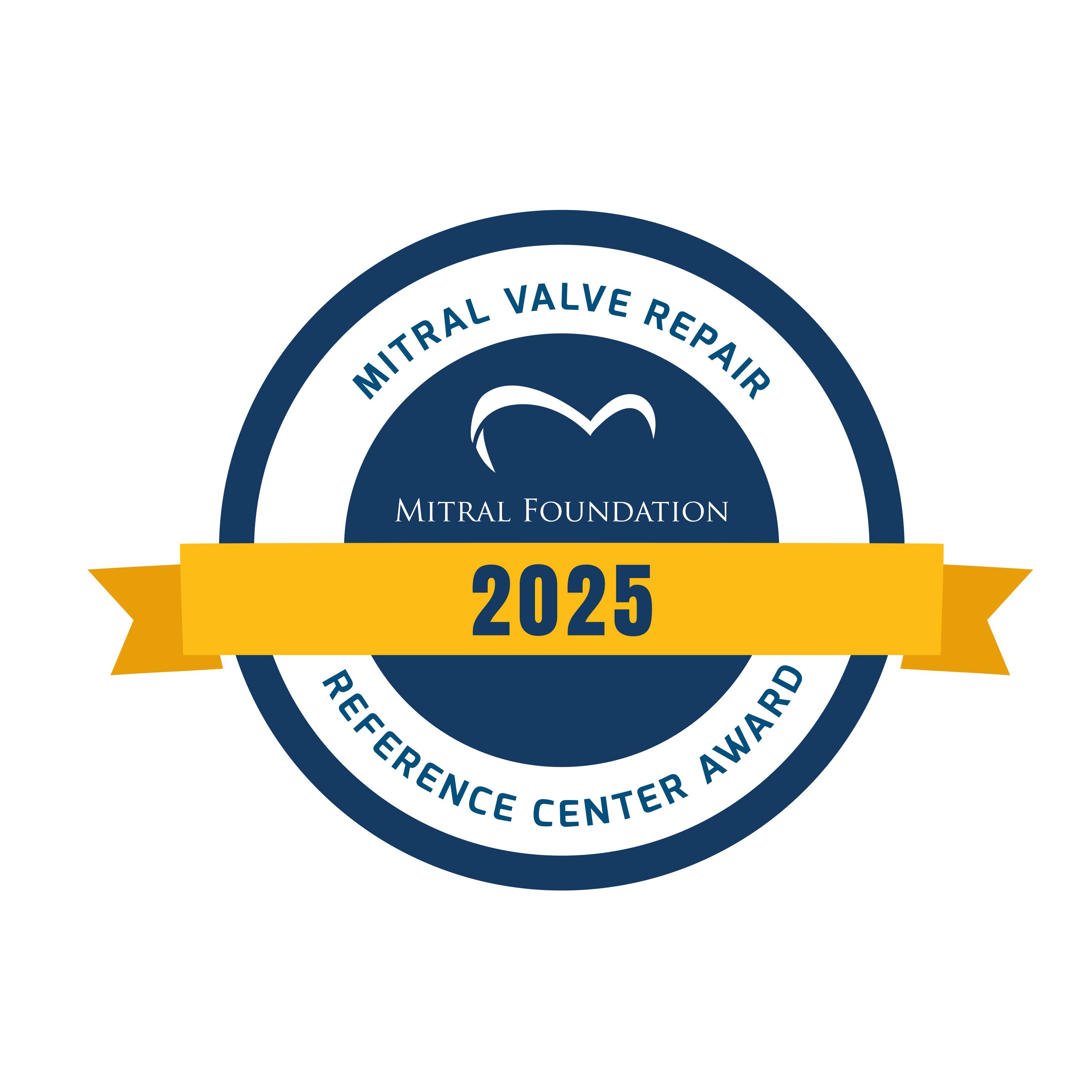
Cardiothoracic Surgery have received the Mitral Valve Repair Reference Center Award from Mitral Foundation for our outstanding work in Mitral Valve Repair Surgery for the 3rd consecutive years.
Heart valves are flaps, or leaflets, of tissue that ensure that blood entering or leaving the heart moves in the proper direction, with no backflow. A heart valve can become dysfunctional in two ways: stenosis or insufficiency. Valve stenosis is due to the inability of the heart valve to open properly. As this tightening of the heart valve becomes increasingly severe, it prevents the heart from being able to pump enough blood through the valve. Valve insufficiency, or regurgitation, is due to ineffective closure of the valve that leads to blood being pumped backwards instead of forward.
The mitral valve controls blood flow between the heart and the lungs. Dysfunction of the mitral valve, whether it is stenosis or insufficiency, results in congestion of blood in the lungs leading to pulmonary edema. Excess fluid in and around the lungs causes shortness of breath and backed up fluid causes swelling or edema in the body and legs.
Mitral insufficiency (a.k.a. mitral regurgitation) is a leakiness of the mitral valve. Normally when the left ventricle, the pumping chamber, contracts blood is pushed out of the heart to supply blood to the whole body. With mitral regurgitation, some of that blood goes backwards through the leaky mitral valve and into the lungs. This leads to increased fluid in the lungs and can cause high pressures in the arteries of the lungs (pulmonary arteries), which causes shortness of breath. If mitral regurgitation is left untreated, the heart becomes progressively dilated and stretched and eventually becomes weakened, leading to congestive heart failure.

America’s 50 Best Hospitals for Cardiac Surgery Award™ by Healthgrade, Superior clinical outcomes in heart bypass surgery and heart valve surgery
Mitral stenosis is a tightening of the mitral valve. This is most often due to rheumatic fever and rheumatic heart disease. The mitral valve leaflets and the supporting structures of the valve, including the papillary muscles and chordae tendinae, become stiffened, shortened, and thickened. The valve becomes immobile and unable to open.
Malfunctioning mitral valves can often be repaired. Weill Cornell Cardiac surgeons are experienced in using a variety of techniques to repair the different types of valves. The optimal care of patients with valve disorders begins with an accurate diagnosis. Weill Cornell employs the latest echocardiography, ultrasound and CT technologies to obtain three-dimensional images of malfunctioning heart valves and peripheral vasculature, which allow us to determine the best course of treatment for each patient. After careful analysis of the valve, a determination is made of the best way to repair it.
- The mitral valve often becomes leaky due to dilation or stretching of the valve. These valves can often be repaired using an annuloplasty ring, which serves to shrink the circumference of the valve back down to normal and remodel the shape of the valve. This reverses the stretching and allows the leaflets to come together, preventing mitral regurgitation.
- Mitral regurgitation is often due to an excess of valve tissue at one site which leads to prolapse of a piece of the valve. This prolapsing segment can be removed and the remaining normal segments of the valve can be sewn back together with fine sutures.
- Another technique for repairing valves with prolapsing segments is to place neochordae, which are synthetic threads that connect the edge of the mitral valve leaflet back down to the supporting structure underneath it, the papillary muscle. These synthetic chordae bring the prolapsing segment of the valve back down to the normal height of the rest of the valve.
- Occasionally the mitral valve does not have enough tissue to function properly. In this situation, one of the leaflets of the mitral valve can be augmented with additional tissue by adding a patch of tissue to the leaflet.
Weill Cornell Cardiothoracic surgeons are skilled in a multitude of mitral valve techniques, allowing us to repair a large number of valves rather than replacing them with prosthetic valves.
If after analyzing the valve it is determined that the valve is too damaged or calcified to repair, then it will be replaced with a prosthetic valve. Weill Cornell Cardiac surgeons are skilled in modern valve replacement techniques. A chordal-sparing technique is used to preserve the supporting structures of the valve, known as the subvalvular apparatus, when we replace your valve.
For appropriate patients, Weill Cornell offers minimally-invasive and robotic mitral valve repair and replacement surgery in addition to standard surgery. We also offer transcatheter approaches including repair and replacement (TMVR). These advanced techniques allow for successful mitral valve surgery through small incisions.











